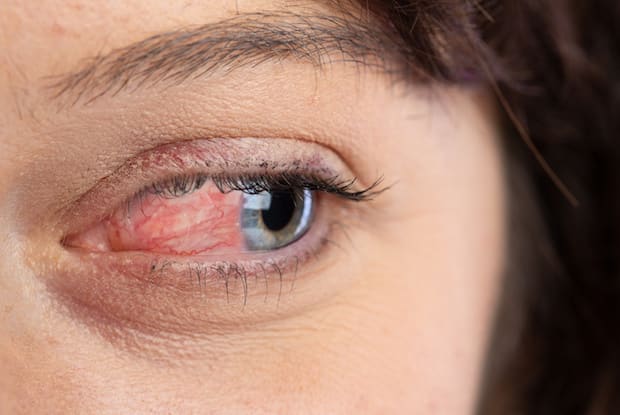Table of Contents
IV. Fair Skin & Family History
V. Alcohol & Cigarette Smoking
Understanding Rosacea
Rosacea affects over 16 million people in the United States. Like many common skin conditions, rosacea symptoms may come and go between periods of remission. [1] This condition is typically chronic, but there are several treatments available like Oracea (Doxycycline Delayed-Release) that can reduce symptoms. In the majority of cases, rosacea affects the face, causing flushing and redness. Over time, this redness can lead to thickening on the nose, called rhinophyma. In many cases, people may mistake rosacea for eczema or acne.
The exact cause of rosacea is unknown, but doctors believe it occurs due to a combination of several factors. Abnormalities in blood vessels are one common cause of rosacea, causing redness in the face. There are several different risk factors for developing rosacea, and you should be aware of any factors that may relate to you. [2]

Symptoms of Rosacea
Facial Redness: Redness is the most noticeable symptom of rosacea. This redness can be persistent and cause the tiny blood vessels on the nose and cheeks to swell and become visible.
Eye Problems: In the long-term, rosacea can begin to affect the eyes (ocular rosacea). This results in irritated, swollen eyes, and red eyelids. Eye problems may occur before skin symptoms.
Get savings updates for Oracea
Red Bumps: Pimples are common on the skin if you are experiencing a rosacea flare-up. These pimples look a lot like acne and make the skin feel hot and tender.
Rhinophyma: As mentioned earlier, thickened nose skin may affect those with rosacea. This can lead to a bulbous nose, which is more common in men than women. [3]
Age & Gender
Rosacea can affect anyone, but it most often occurs to women between 30 and 50 years old. Women are three times more likely to get this skin condition. Doctors believe this is because women go through more hormonal changes than men. Women may have hormone spikes and dips throughout their life because of childbirth, menstrual periods, and menopause.
In the case of menopause, hot flashes may trigger flushing of the chin's cheeks and redness. Menopause is a common trigger for rosacea, and flushing of the face may occur in flare-ups even after a woman is in post-menopause.
On the flip side, men may experience more severe rosacea forms because they are more likely to ignore the symptoms. This is one reason why men are more likely to get rhinophyma. Men are more likely to mistake the redness for sunburn or allergic reactions. [4]
Fair Skin & Family History
Those with fair skin are much more likely to get rosacea than those with darker-toned skin. When blood vessels dilate and form spidery red lines, they are much more visible on lighter skin. This skin condition can affect all population segments, but those who are pale and blush easily are at the greatest risk. Because of this, rosacea is more common in people of northern or eastern European descent. [5]
Rosacea can be caused by a combination of genetic and environmental factors. If your father or mother has rosacea, it is not 100 percent likely that you will also get rosacea, but your risk is increased. Researchers have found that those with rosacea in their family history are four times more likely to get this disorder than those without genetic influences. [6] Many lifestyle choices can affect the development of rosacea. The American Academy of Dermatology Association (AAD) found that women who drink alcohol have a higher risk of this skin disorder than those who do not drink. The study found that women who drank white wine or hard liquor are at the greatest risk. AAD’s study collected data from 82,737 women over 14 years. The study also addressed the rumor that a red face indicates alcoholism. This is not true because people who never drink also get rosacea and alcoholism does not cause rosacea. [7] Along with the other significant heart and lung consequences, smoking can also affect the skin. One study in Turkey studied 400 people and compared rosacea with 200 people who do not smoke with 200 current smokers. The study found that the incidence of rosacea was much higher in those who do not smoke. Researchers found that 66 percent of rosacea patients were active smokers. This may be linked to nicotine in cigarettes, which stimulates blood vessels and may cause inflammatory effects, increasing the rate of skin redness. [8] Regardless of your risk factors for skin problems, it is essential to protect your skin from excessive sun exposure. Failing to wear sunscreen or wear protective clothing can significantly increase your risk for skin cancers as well as rosacea. Dermatologists have found that even a few minutes in the skin can cause rosacea-prone skin to flush and become red. Sun is one of the most common triggers for rosacea, so it is important to wear sunscreen that is at least 30 SPF along with a hat to protect your face. [7] Many people may think stress is just mental, but it can affect many physical body processes, including the skin. When you are stressed, the body releases adrenaline and cortisol, resulting in physical symptoms like weight gain or loss, acne breaks out, and hives. Those who are already at risk for rosacea may experience rosacea flare-ups as a result of their stress. It is important to limit your stress and find peaceful activities that will benefit your mind and body. [6] The content in this article is intended for informational purposes only. This website does not provide medical advice. In all circumstances, you should always seek the advice of your physician and/or other qualified health professionals(s) for drug, medical condition, or treatment advice. The content provided on this website is not a substitute for professional medical advice, diagnosis, or treatment.
Alcohol & Cigarette Smoking

Sun Exposure & Stress
